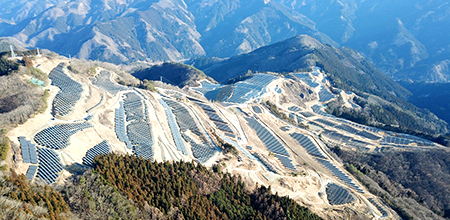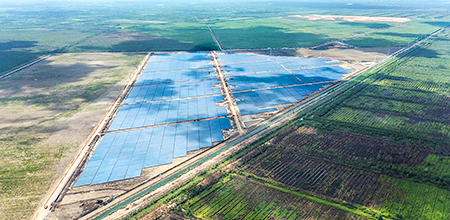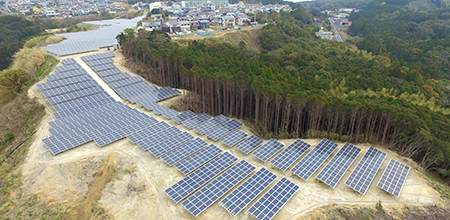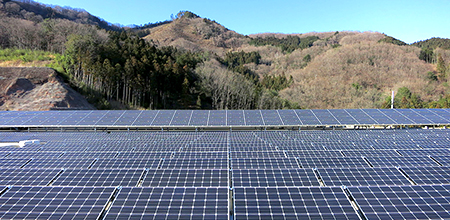Solar power generation business

If we don't halve CO2 emissions by 2030, the chain of global warming will become unstoppable.
Amid the global call for environmental measures, including addressing global warming, Japan has also set the goal of "Carbon Neutrality by 2050". According to a survey conducted by NHK among 100 domestic companies, only 13 companies believe they can achieve this goal, while 65 companies stated they could achieve it with conditions such as government support. Additionally, a similar survey conducted by the Teikoku Databank among over 11,479 companies, which is more than 100 times the NHK sample size, revealed that only 2.5% of the companies believed the goal was achievable with current efforts, and 13.3% believed it could be achieved by intensifying efforts. Thus, only 15.8% of the companies expressed confidence in achieving the goal with efforts, while 61.3% of the companies, combining 43.4% finding it difficult to achieve and 17.9% believing it was unattainable,
Amid the global call for environmental measures, including addressing global warming, Japan has also set the goal of "Carbon Neutrality by 2050". According to a survey conducted by NHK among 100 domestic companies, only 13 companies believe they can achieve this goal, while 65 companies stated they could achieve it with conditions such as government support.
Additionally, a similar survey conducted by the Teikoku Databank among over 11,479 companies revealed that only 2.5% of the companies believed the goal was achievable with current efforts, and 13.3% believed it could be achieved by intensifying efforts. Thus, only 15.8% of the companies expressed confidence in achieving the goal with efforts, while 61.3% of the companies, combining 43.4% finding it difficult to achieve and 17.9% believing it was unattainable,
However, in January 2021, NHK aired a program stating, "If CO2 emissions are not halved by 2030, the chain of global warming will become unstoppable." In other words, it suggests that relying solely on the current national goals is too late. The title of this program was "2030: The Crossroads to the Future - Episode 1: Challenging Runaway Global Warming with 'Decarbonization'". It indicates that the focus is on 2030, rather than Carbon Neutrality by 2050, and emphasizes that without halving CO2 emissions within this decade, it will undoubtedly be too late.
We should focus on the global environment rather than short-term gains.
However, the reality feels even more daunting.
According to records of global CO2 emissions since 1980, China's emissions have increased by 6.7 times by 2019. It's surprising that these figures fall within the scope of the Paris Agreement. This is because reduction targets for emissions in developing countries like China are relative to their rapidly growing GDP. Even if China aims for a 60% reduction in emissions relative to GDP by 2030, considering a tenfold increase in GDP, it would still emit up to 240 billion tons.
In such a scenario, in September 2020, the European Commission President, Ursula von der Leyen, raised the EU's target for CO2 emissions reduction from 40% to 55% by 2030. While this is a remarkable commitment, the effort cannot be solely on the EU. As mentioned earlier, there are only nine years left until 2030, and unless other countries also halve their emissions, no matter how much a country develops, it won't be livable.
We believe it's time to stop focusing on short-term gains and start looking at the bigger picture, considering the forest and the mountains rather than just the trees and the deer. While the world may have temporarily prospered due to fossil fuels, the cost is evident. Pursuing short-term and temporary gains for one's own company or country, akin to chasing deer for temporary profit, may ultimately lead to perishing in the mountains.
Abnormal weather events are already occurring frequently worldwide this year.
At this rate, not only countries but the Earth itself will become uninhabitable.
Year by year, these signs are becoming more pronounced. In 2021, Japan experienced record-breaking heavy snowfall in the Tohoku region and western Japan. This was due to increased evaporation of seawater caused by rising sea temperatures due to global warming, bringing moist air over the Sea of Japan. Similarly, in Hokkaido, a low-pressure system moving northward from southern Kyushu over the Pacific Ocean rapidly intensified due to April-level sea temperatures, growing into a bomb cyclone with a central pressure of 946 hPa and strong winds of 44.9 m/s.
Abnormal cold waves also occurred in the southern United States. In February 2021, temperatures dropped below zero, a rarity even in winter, in states like Texas and Oklahoma, recording temperatures below -10 degrees Celsius for over a week. Oklahoma City recorded -25.6 degrees Celsius, and Dallas recorded -18.9 degrees Celsius. This cold wave caused power outages for 4 million households in Texas, despite the state's robust power system. Initially, incorrect information circulated suggesting that the freezing and cessation of wind and solar power generation systems caused the outages, but in reality, the effects of turbine freezing and shutdown on wind power generation were partial. The main cause was the freezing of pipelines for natural gas facilities, which accounted for more than half of the power supply. Some people died due to the lack of heating equipment during the power outage.
In Australia, massive wildfires occurred in Western Australia, while New South Wales experienced temperatures exceeding the annual average by 10 degrees Celsius, accompanied by flooding in towns.
Weather events like these, previously described in the news as occurring once every 500 years, have changed to occurrences once every 100 years, several decades, and more recently, once every few years. However, in reality, they happen every year, sometimes multiple times a year.
Now is the time to urgently introduce renewable energy and establish diverse power generation systems that can not only mitigate global warming but also withstand events like cold waves. Specific examples include double-sided solar panels that generate electricity even during snowfall, wind power that can adjust rotation even during storms, and biomass with sufficient raw material stockyards to continue operation during traffic blockages. With current technology, these measures are entirely feasible.
As mentioned in the NHK special, unless we halve CO2 emissions by 2030, the Earth's average temperature will rise by more than 1.5 degrees Celsius, and the chain of global warming will become unstoppable.
However, there are already reports that Arctic ice has halved in the past 40 years. This suggests that the chain of global warming has already begun. When Arctic ice melts, heat that was previously reflected by the white ice is absorbed by the dark sea, raising temperatures in the Arctic Ocean and causing the thawing of permafrost in surrounding areas like Siberia. This leads to the release of methane gas, which has a warming coefficient 25 times that of CO2. This will accelerate global warming, causing forests, which should absorb CO2, to catch fire and release even more CO2.
Rather than relying on others, it's time for action now.
Japan currently ranks 5th in the world in terms of CO2 emissions, but its per capita emissions are higher than those of China, which ranks first in quantity. Considering the world's population ratio, Japan's emissions should be at least below 1.6% of the world's total, yet they exceed 3.6%. In other words, Japanese individuals emit more than twice the global average of CO2.
The world needs to halve emissions by 2030. If that's the case, Japan has less than 10 years to not only bring its emissions down to the global average but also cut them by half, which means reducing current emissions to less than a quarter. Now is the time for Japan to focus on the root of the problem, which not only affects its own country but also destroys habitats in other countries, rather than prioritizing its own interests.
Our company is involved in renewable energy project development from inception. While there are risks involved in project development, someone has to take the initiative. The environmental situation on Earth is deteriorating rapidly, and aiming for carbon neutrality by 2050 is already too late.
This is why our company continues to challenge itself in the field of renewable energy.
An example of a project

Development and construction achievements of Shoei Create Co.

Kaminarucho Solar Power Plan(20MW)
Kaminari-cho, Tano County, Gunma Prefecture / Field / 20,636kW / Completed in November 2020 / Development, Civil Engineering, EPC, O&M

Ho Chi Minh City, Vietnam Hoang Khao Solar(100MW)
Long An Province, Vietnam / Field / 100,000 kW / Completed in June 2019 / Civil and EPC

Tosashimizu Power Plant(1.6MW)
Tosashimizu, Kochi / Field / 1,582 kW / Completed in March 2016 / Development, civil engineering, EPC, O&M

Nagatoro Shooting Range Power Plant(1.3MW)
Nagatoro-cho, Chichibu-gun, Saitama / Field / 1,339kW / Completed in March 2015 / Development, Civil Engineering and EPC
